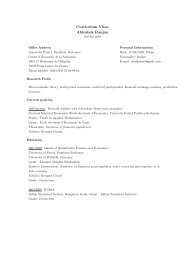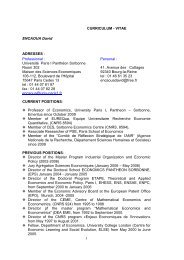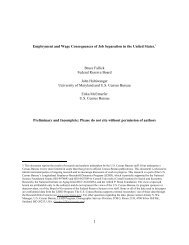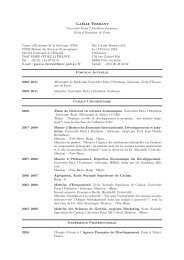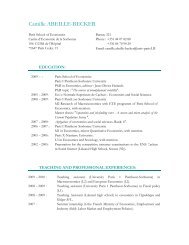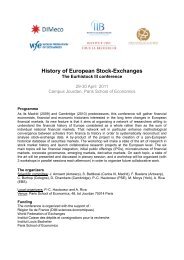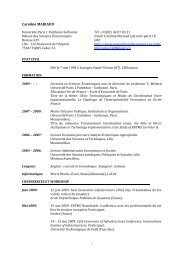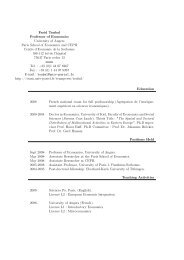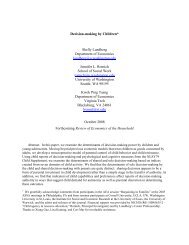info document - Paris School of Economics
info document - Paris School of Economics
info document - Paris School of Economics
Create successful ePaper yourself
Turn your PDF publications into a flip-book with our unique Google optimized e-Paper software.
the prices <strong>of</strong> both raw labor and human capital (see equation (2)), whereas the marginalbenefit is only proportional to the price <strong>of</strong> human capital. As a result, a higher level <strong>of</strong> θ H(for example, due to SBTC) increases the marginal benefit more than the marginal cost,resulting in higher investment. This feature is an important difference between the currentframework and the standard Ben-Porath model (studied in section 2.1. Compare (13) to (4)and (5). In the latter, a higher price <strong>of</strong> human capital (which is the only factor <strong>of</strong> productionsince there is no raw labor) affects the cost and benefit <strong>of</strong> investment exactly the same way,leaving the trade-<strong>of</strong>f—and therefore the investment decision—unaffected. It is precisely forthis reason that it is difficult to think <strong>of</strong> the concept <strong>of</strong> “returns-to-skill” in that framework,because a higher price <strong>of</strong> human capital has no effect on the decision to invest. Instead in thepresent model θ H /θ L is a measure <strong>of</strong> returns-to-skill, and affects investment in human capitalwithout necessarily implying anything about aggregate productivity (which is captured byZ and also has no effect on investment incentives for the same reason discussed for theBen-Porath model).Using (13), optimal investment choice can be solved for explicitly:Q j s = ( A j) 1/(1−α) α/(1−α)[αMB] . (14)This expression highlights the main sources <strong>of</strong> heterogeneity in this model: (i) individualswith higher learning ability invest more in human capital: ∂Q j s/∂A j > 0; (ii) moreimportantly, their investment responds more strongly to SBTC: ∂ 2 Q j s/∂θ H ∂A j > 0; (iii)investment goes down over the life cycle: ∂Q j s/∂s < 0; and finally, younger individualsrespond more strongly to SBTC: ∂ 2 Q j s/∂θ H ∂s < 0.4 Quantitative Analysis4.1 Calibration [subsection to be revised]Our basic calibration strategy is to take the United States as a benchmark and pin downa number <strong>of</strong> parameter values by matching certain targets in the US data. We then assumethat other countries share the same parameter values with the US along unobservabledimensions (such as the distributions <strong>of</strong> true ability and raw labow), but differ in several dimensions<strong>of</strong> their labor market policies that are feasible to model and calibrate (specifically,consumption and labor income tax schedules, retirement pension system, unemploymentinsurance system, and finally legal minimum wages). We will then examine the differencesin economic outcomes—specifically in wage dispersion, output, and labor supply—that are23



